Content
Today, ginger root can be purchased without any problems. How to grow ginger from the root at home? Has this question never crossed your mind? It turns out you can. It can be on the windowsill, or in the garden.
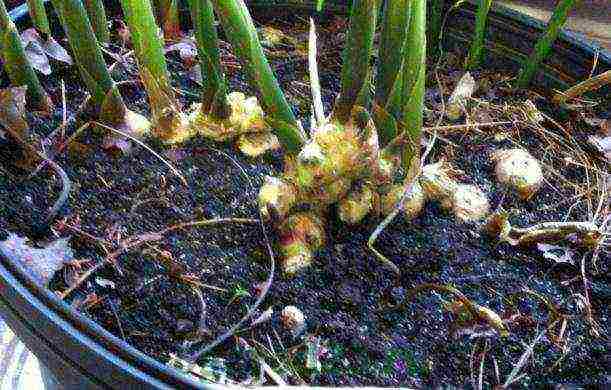 Thanks to its medicinal properties and fat-burning effect, this healthy spicy-spicy tuber has become incredibly popular, by the way, deservedly so.
Thanks to its medicinal properties and fat-burning effect, this healthy spicy-spicy tuber has become incredibly popular, by the way, deservedly so.
At home, ginger is planted in winter or early spring. The planting soil should be soft and loose so that the sprouts can easily make their way through it. At the initial stage of cultivation, you can feed the soil with potash fertilizers.
The ginger pot should have a wide bottom, because the growth of the tuber is mainly in breadth. At the bottom of the container, you need to pour expanded clay drainage (4-5 cm), and then the soil. You can purchase special soil for growing vegetables in advance, or you can mix soil, turf, deciduous humus and sand in equal parts.
↑ back to contents ↑ How to plant ginger root?
First you need to choose high-quality planting material - a smooth and healthy, not overdried root. Since ginger reproduces by dividing the tuber, the planting root should have many shoot buds (“eyes”) on its surface. These sprouts are somewhat reminiscent of potato "eyes" and perform a similar function.
Choose for planting plump roots, without wrinkles, with several "fingers", with visible eyes at the end of the "fingers". Ideally, those little eyes would have turned green, but generally speaking, this is not necessary.

Before you buy ginger root for planting, make sure it hasn't been in the freezer.
In order for the buds to "wake up" and activate, you can soak the root in warm water for 3-4 hours, and then cut (cut along the bridges) into separate fragments. Some gardeners recommend soaking the tubers in a not very strong solution of potassium permanganate. The area of the cut can be sprinkled with crushed coal (activated pharmacy or ash).
As mentioned above, ginger root is planted in early spring.
Ginger prefers partial shade or areas in which the sun is from morning to noon. The landing site should be protected from the wind, the soil is moist and warm - somewhere between 22 ° and 25 ° C.
In the tropics in its homeland, ginger grows in full shade, but, for example, in the middle lane, a shady place may be too cold for it.
Ginger grows slowly, especially outside the tropics. If you're lucky, the sprout may appear in a few days. But usually it takes at least two weeks.
It takes 8-10 months to fully ripen, so by the onset of winter you can already reap the fruits of your own harvest. Under natural conditions, ginger is a perennial plant, but in the domesticated version it will be an annual.
Under natural conditions, ginger is a perennial plant, but in the domesticated version it will be an annual.
The ginger root must be deepened by about 3 cm, while the sprouts (eyes) should look up. After planting, cover the tubers with soil and water. It is better to place the pot itself where it will be cool, no more than + 15 ° C, where it will be dry, there will be no direct sunlight.
The first shoots usually appear after 12-14 days, until this time it is not necessary to overfill the soil with water too actively (so that the roots do not rot) - it should be slightly damp.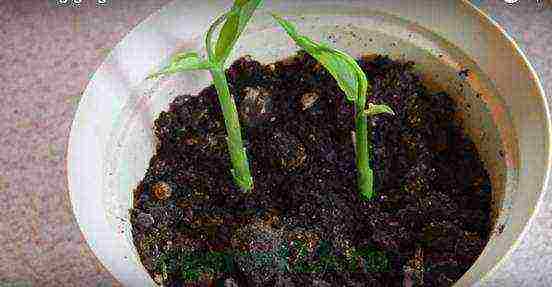
↑ to the content ↑ How to grow ginger from the root - care
Ginger root maintenance while growing is regular but moderate watering. Do not allow the soil to dry out, as well as too abundant moisture. During the growing season, ginger can be fertilized with mullein diluted in water (1 in 10), about once every 3 weeks. After each watering, it is recommended to loosen the top layer of the soil, and if you irrigate the stem with a spray bottle every day, the ginger will thank you.
By about the end of September, when the stems and leaves of the plant begin to turn yellow, dry out, the frequency of watering should be minimized, and irrigation should be stopped altogether.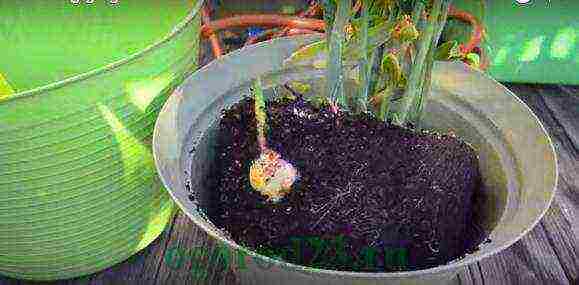 By the time the ground part of the ginger is completely dry, you can dig up the tubers. After removing from the ground, ginger is cleaned of soil residues, adventitious roots are removed, and dried in an open, sunny place for several days.
By the time the ground part of the ginger is completely dry, you can dig up the tubers. After removing from the ground, ginger is cleaned of soil residues, adventitious roots are removed, and dried in an open, sunny place for several days.
If you have the opportunity to take pots of ginger to the street (cottage, courtyard of a private house), then a shaded area, for example, the shadow of a tree or a spreading bush, will be the best place for a plant. Ginger is a light-loving plant, but, at the same time, the direct rays of the sun are destructive for it.
When you grow ginger in the manner described above, you will not see it blooming. It blooms in the second year, if at least part of the root was left in the ground for the winter. It is unlikely that he will survive in mid-latitudes. I think that only residents of the southern regions, for example, the Black Sea coast, will be able to see ginger in bloom. But even they should cover the ginger roots left for the winter with mulch.
Below you can watch a video with a photo of a blooming ginger.
The cultivation of this crop will not bring you any particular difficulties. Like any plant, ginger needs care and attention. Therefore, any gardener, both beginner and experienced, can grow ginger from the root. If you love this spicy and healing tuber, then don't miss this opportunity.
Video: How to plant and care for ginger.
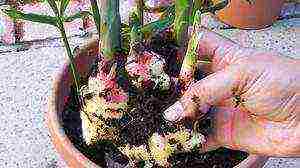 In many countries, various plants are used for medicinal purposes. For many centuries, natural remedies have been reliable assistants for doctors and healers. However, some medicinal plants can be successfully grown at home.
In many countries, various plants are used for medicinal purposes. For many centuries, natural remedies have been reliable assistants for doctors and healers. However, some medicinal plants can be successfully grown at home.
For example, ginger is a medicinal herb whose roots are great for dealing with flu and other illnesses. But, besides this, it can also become a beautiful decoration for your home. How does ginger grow, and what you need to know to grow it at home?
What is Ginger
 To understand how to grow, you need to know where ginger grows. This plant is native to Asia. Here, in a warm and humid climate, ginger grows in the wild.
To understand how to grow, you need to know where ginger grows. This plant is native to Asia. Here, in a warm and humid climate, ginger grows in the wild.
This fact must be taken into account when growing. Ginger roots have branches in the form of "horns", this form gave the name to the plant.
Rhizomes are an important element, it is from them, or rather, from the buds located on the roots, that new shoots grow. The leaves of the plant are large. The shoots themselves, which at home can grow up to one meter, are very similar to reeds.
But the most valuable thing, as already mentioned, is the roots. The color of their flesh, at a young age, is white. Over time, the tonality changes to yellow. It is the roots that are mainly used for medicinal purposes.
Planting a plant
Ginger can be propagated by both seeds and rhizomes. But it is the second method that is the most common. The process of planting a plant itself can be roughly divided into the following stages:
-
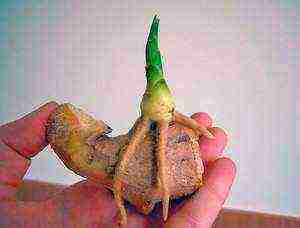 First of all, you need to choose the right ginger rhizome. When buying, you need to pay attention to the appearance.The root should have a smooth surface, a fibrous structure (which will indicate that the rhizome is already several years old, and sprouts will appear from it faster) and a large number of buds.
First of all, you need to choose the right ginger rhizome. When buying, you need to pay attention to the appearance.The root should have a smooth surface, a fibrous structure (which will indicate that the rhizome is already several years old, and sprouts will appear from it faster) and a large number of buds. - In addition, there should be no dark spots and traces of mold on the planting material.
- Stimulation of the emergence of sprouts. The rhizome must be placed in warm water for several hours. If the root is fresh, then this procedure is not required.
- Preparing the material for planting. The ginger rhizome can be cut to grow more plants. But this must be done strictly along the lines of the jumpers. At the same time, make sure that there are several buds on each piece.
- After that, the root can be kept for several hours in a weak solution of potassium permanganate or sprinkled with chopped coal.
- Preparing the soil. Ginger loves rich and breathable soils. You can purchase a ready-made mixture intended for ornamental plants (with neutral or weak acidity). If you decide to do everything yourself, then take turf, humus and sand in equal proportions.
- Landing. The root is deepened into the ground by no more than two centimeters. In this case, you need to make sure that the kidneys are looking up. Do not allow contact of the rhizome with the walls of the container, so that rot does not form.
After planting, you need to constantly maintain the soil. wet, also the container should be in a warm room. In this case, the sprouts will appear in 2-8 weeks. The shoots grow unevenly. The first sprout may already be with leaves when the next one appears.
Ginger care at home
 You should immediately decide why you are going to grow ginger - to obtain rhizomes or as an ornamental plant. It is on this choice that the approach to plant care methods will depend.
You should immediately decide why you are going to grow ginger - to obtain rhizomes or as an ornamental plant. It is on this choice that the approach to plant care methods will depend.
The homeland of ginger is distant Asia, so if you want to get a healthy and useful plant, then you should take care of the care more carefully.
Good growth will be ensured if the following requirements are met:
- special watering regime;
- organization of the necessary lighting;
- compliance with the temperature regime;
- maintaining the desired level of air humidity;
- timely and high-quality feeding.
Type of flower and root of ginger
Ginger grows in humid climates, so regular watering is very important... In this case, it is necessary to use soft water at room temperature (preferably settled for at least two days).
Make sure that the soil is always moist, especially for the period of flowering and vigorous growth. But stagnation of water should not be allowed, in this case the roots will begin to rot.
Place the containers with the plant on the west or east windows. Ginger loves light, but at the same time it does not tolerate direct sunlight. In winter and in cloudy weather, it is better to additionally resort to artificial lighting.
You also need to be careful with the temperature. The optimal regime for growth will be warm in the region from +28 to +32 degrees. This applies to the summer period, in winter a lot will depend on your desires.
In winter, ginger can be given a "rest" time, in which case the temperature should be within 10-15 degrees above zero (the "rest" state contributes to the rapid appearance of flowers).
If you decide to grow the plant all year round, then the temperature must be kept high. But the main thing is avoid sudden changesespecially drafts in winter.
Ginger is native to humid forests, so there should be enough moisture in the air. It is necessary to carry out daily spraying the leaves.
But this procedure is carried out only during the growth period. If in the winter you start a "dormant" period, then the spraying must be stopped. In this case, you should not be afraid of wilting, and even leaf fall.
This plant loves rich soil. You need to make every ten days special fertilizer complex... If you don't find one, then a weak mullein solution will do just fine. Closer to autumn, you need to alternate such top dressing with the introduction of potash fertilizers.
Ginger is a beautiful and healthy plant. Its homeland is the humid forests of Asia and this imposes special requirements for care. Regular watering, humidifying the air, spraying, feeding and warmth are the basic prerequisites for good growth.
At first glance, such requirements seem to be quite time consuming, but in fact, leaving will not take much of your time and effort. Just 10-15 minutes a day and a beautiful bush with a bright flower will turn green on your windowsill, which, if necessary, will help you cope with many diseases.
Ginger is a commonly used herb. Tea made from it with honey and lemon is a powerful antiviral agent that helps with colds and flu. We usually buy ginger in the store, but it is not difficult to grow it at home. You will learn how to grow ginger at home in this article.
Features of growing ginger at home
This plant is a resident of tropical countries. It is hot there and a lot of moisture, so in the apartment it will be necessary to create similar conditions for the plant. In the tropics and subtropics, ginger is a perennial. Indoors and outdoors, it is usually grown as an annual crop.

If you want the plant to overwinter and please with flowering, which happens only in the second year, you can dig up the rhizome grown in the garden and transplant it into a pot. The root of ginger is fibrous - it will feel good in a pot. You just need to remember that ginger can grow up to a meter or more in height, so the plant needs to choose the appropriate place where it will be spacious.
Preparing for landing
To grow ginger from the root, you need to prepare it first. Like any cultivated plant, ginger has a variety of varieties to grow. Some of them not only give a good harvest of rhizomes, but also have a long, beautiful flowering, and therefore can serve as a decorative element of a flower garden.
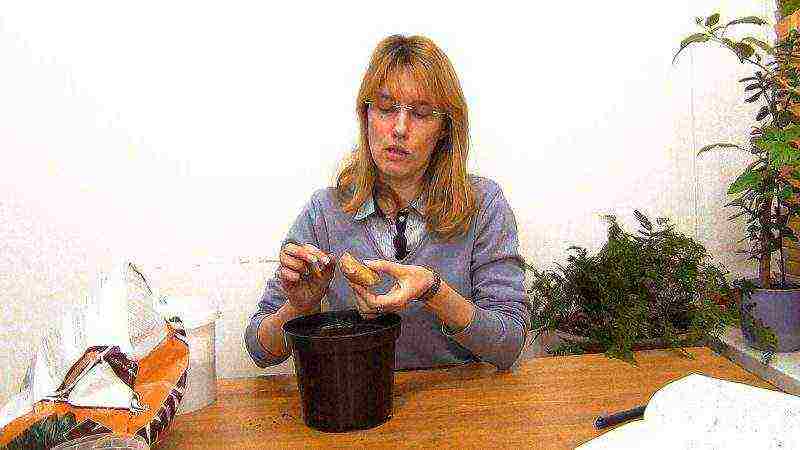
- Zerumbet - has flowers similar to roses.
- Wonderful - it has a long bloom of scarlet flowers.
- Kasumunar - Its white flowers are similar to orchids.
- Purple - powerful stems bear flower stalks with decorative flowers.
- Japanese - blooms early, flowers have a scent.
Of course, in the store it is hardly possible to find out which variety the selected root belongs to. Growing it as an ornamental plant is fraught with great difficulties: you need to withstand a certain temperature regime, air humidity and other parameters. It is difficult to keep all this in an apartment. Therefore, we will limit ourselves to the cultivation of spicy rhizomes. By the way, they are most delicious in the first year of life, and with further cultivation they not only coarse, but also acquire excessive bitterness.
To grow ginger from the root, you need to choose and prepare it correctly. We choose a rhizome with a large number of eyes. The lighter the skin, the less it has been stored. Sometimes on sale you can find a rhizome peeled and processed in a special way - it is not suitable for planting.
Root soak
In order for the eyes to sprout as soon as possible, the rhizome needs to be "awakened", since it dries up a little during storage. It is enough to soak it for 2-3 hours (the water is taken warm for this).
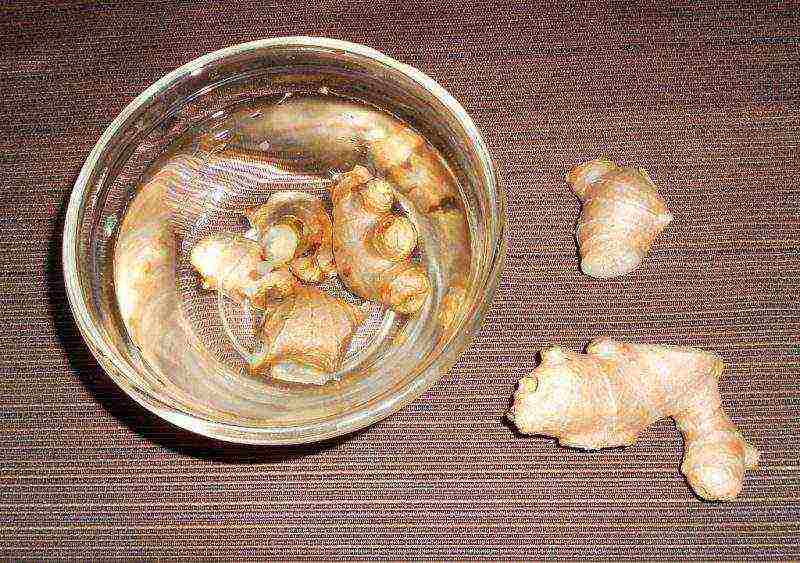
Further preparation process:
- cut along the jumpers so that there is at least one kidney on each piece;
- we disinfect pieces of rhizome in a slightly pink solution of potassium permanganate;
- Sprinkle the slices with crushed coal.
Disembarkation
For planting, a large-diameter pot is selected so that the rhizomes have where to grow and of sufficient height if ginger will grow in the room for more than one year.For growing ginger at home on a windowsill, nutritious garden soil or any purchased soil for garden crops is suitable, as long as it is loose and has a neutral reaction.

- Spill the soil with Fitosporin solution.
- Be sure to place drainage at the bottom of the pot.
- Don't forget the water drain hole.
- Place a piece of a tuber or a whole rhizome in a moistened soil to a depth of about 2 cm, bud upwards.
Sprouts of ginger
We are waiting for seedlings, from time to time moistening the soil in the pot. This usually takes about a month. All this time, the pot should be in the light and warm. If the air in the apartment is very dry, you can put a plastic bag on the pot. Such a procedure will not only provide greenhouse conditions for plantings, but also accelerate the emergence of seedlings by 2 weeks. If planting was carried out in late winter or early spring, then there is a chance not only to get a harvest of rhizomes, but also to see the flowering of the plant.
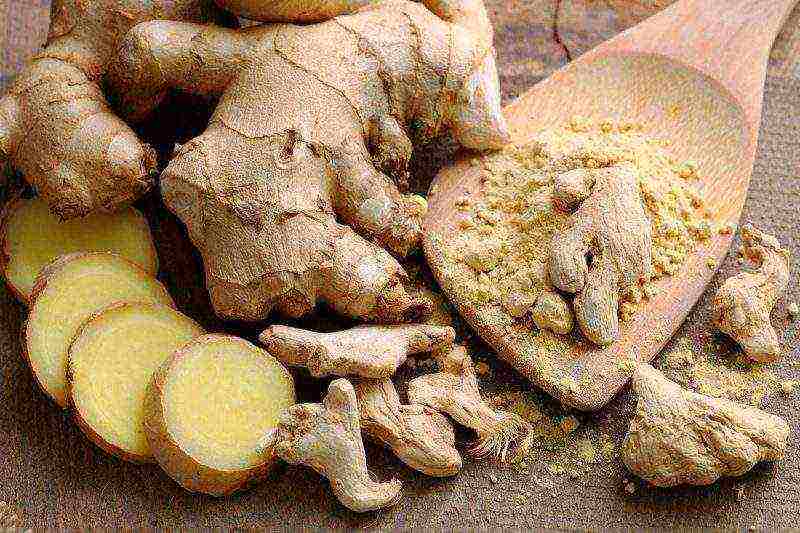
Home Ginger Care
For a plant to develop well, it needs conditions close to natural.
Special conditions: lighting, temperature
For ginger, the temperature range from 25 to 33 degrees Celsius is considered comfortable, but he does not like sudden changes in temperature. The best light for him is diffused, and the midday bright sun rays will not benefit ginger. Therefore, we choose an east-facing window sill for growing it. In a warm summer, he will feel good on the loggia or even in the garden, if you protect him from the scorching sun and strong winds.
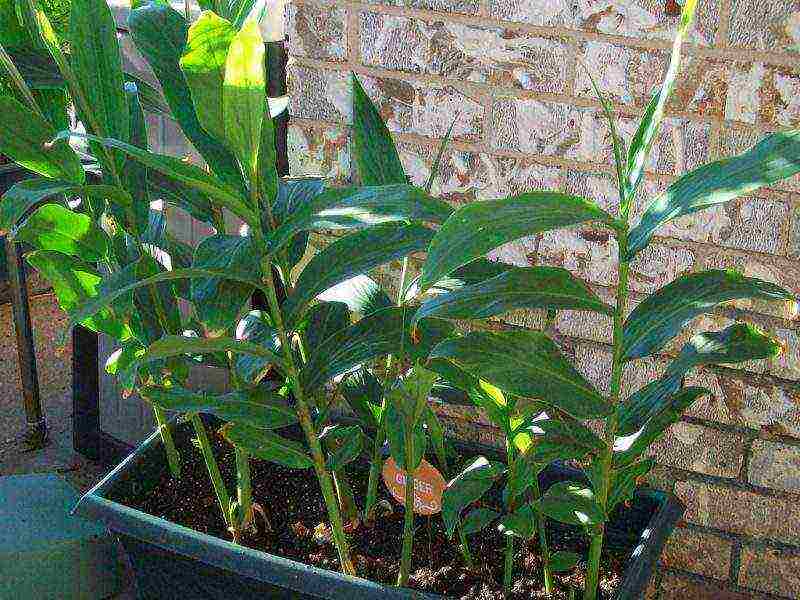
Watering, feeding, loosening
Ginger loves moisture, but stagnation can cause root rot. The soil in the pot should always be slightly damp, because the higher the temperature, the more often the plant needs to be watered. In the middle of autumn, watering is reduced, drying an earthen lump - so the rhizomes will gain a large mass.
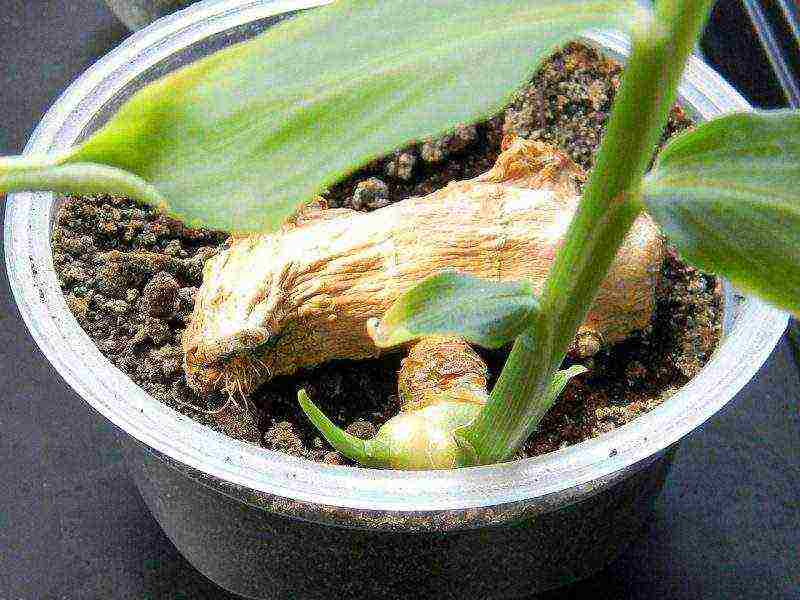
Top dressing of ginger is carried out with full mineral fertilizer once every 2-3 weeks. It must be combined with watering. Ginger gratefully responds to spraying with warm water.
If the plant is grown for flowering, phosphorus should prevail in the fertilizer mixture, it needs more potassium to form rhizomes.
So that the air flows freely to the roots, the soil in the pot is loosened every week, but shallowly, so as not to disturb the growing rhizomes. With good care, the plant quickly grows leaves, which, by the way, can be eaten. You should not be zealous with cutting them, otherwise the growing rhizomes will not have enough nutrition, they will grow more slowly and become small.
Ginger harvest
In order for full-fledged rhizomes to grow, ginger takes about 8 months. Usually in the fall, the plant begins to prepare for the dormant period - the stems fall apart, the leaves turn yellow and fall off. If you want the plant to overwinter, take it to a room with a temperature of about 15 degrees. The plant does not need light or feeding at this time. It is enough to slightly moisten the earthen lump several times during the winter.

If the purpose of cultivation was to obtain a harvest, the rhizomes must be dug up, freed from adventitious roots and dried. Dig out the rhizomes with your hands so as not to damage them.
Outdoor growing rules
They are no more difficult than growing in a room.
In warm regions, the plant will be comfortable without any shelter when planting directly into the ground. In cool climates, it is better to grow ginger in a greenhouse, planting it for preliminary germination in the middle of winter in pots at home.

Growing rules:
- we select a place in the partial shade of other crops, but with a sufficient amount of diffused light;
- the soil must be fertile, so we fill it with humus and complete mineral fertilizer;
- if the soil is light, you can do without drainage, otherwise we put small pebbles and a layer of sand on the bottom of the hole 20 cm deep, the thickness of both is 2 cm;
- we fill the pits with soil and plant the grown plants, watering them well;
- water the plants as needed, preventing the soil from drying out;
- we feed 2 times a month with organic fertilizers or herbal infusion;
- in August, we carry out top dressing with potassium sulfate;
- from the beginning of September we stop watering.
How to protect ginger from diseases and pests?
Ginger is quite resistant to diseases and does not suffer from them with proper care. Of the pests, he can be annoyed by the scourge of all indoor plants - the spider mite. The most radical way to combat it is by spraying with acaricides. But for a culture used for food, this is not desirable. Therefore, you can arrange a shower for the plant every 2 weeks with hot (but not higher than 40 degrees) water with washing the leaves with soapy water.
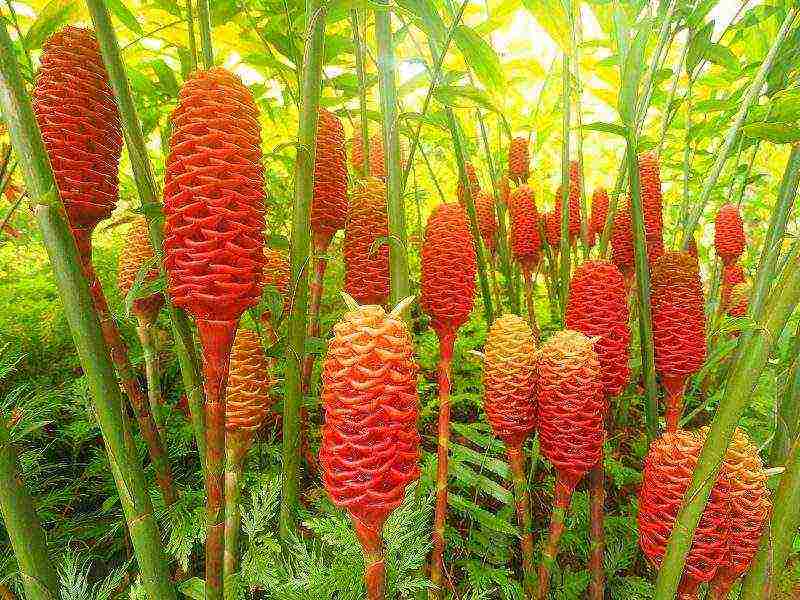
A good way is to rub the leaves and stems with 96% concentration of rubbing alcohol. This procedure is carried out quickly so as not to burn the plants.
Growing ginger at home and on the street is an exciting activity, and a good harvest of rhizomes will provide an environmentally friendly food product for a long time.
Ginger is a spice, ornamental and medicinal plant at the same time. The root has the greatest number of useful characteristics.
The full name is medicinal ginger. In its natural state, it grows in the tropics. In ginger, the leaves are of a linear type, located on the stem alternately. The underground part of the plant is usually called the root, but it is the rhizome. It has several parts and looks like a hand.
Growing ginger roots
Often people are interested in the question: is it possible to grow ginger from a root purchased in a store. This can be done and relatively easy. When buying, you must choose the most fresh a root that has a smooth and shiny surface. A small piece is planted, about two sections long. Live kidneys must be present on it. If the rhizome has dried out during storage, then it must be immersed in warm water for several hours. The dormant buds will awaken and then sprout. Often, sprouts appear without additional action at the roots, which were stored at room temperature in a lighted place.
Consider how to grow ginger at home. It is required to take a large and wide container with high quality soil for growing vegetables. They are introduced into the soil in advance top dressing, which is intended for growing root crops and contains a lot of phosphorus. A root is laid in the prepared ground. The buds should be located on the part that turned out to be at the top. To grow ginger from the root at home, you do not need to bury it deeply. It is enough to cover with a layer of soil a couple of centimeters thick.
The soil should be slightly damp before sprouting. Watered very little. If water suddenly stagnates in the container, then the root will begin to rot.
When the first shoots emerge from the ground, the plant follows feed... Top dressing should be done regularly, every two or three weeks, until autumn.

Is it possible to grow ginger from the root at home? Photo
In warm summer, the plant feels good on outdoors... But this way you can grow ginger at home only if the air temperature remains comfortable even at night.
They put the ginger in a well-lit place, but the sunlight should not enter. Dislikes plant and wind. The greenhouse creates optimal conditions: good illumination, significant temperature and humidity, no wind. Sometimes the plant in the greenhouse needs to be shaded.
Watered ginger is very active in the hot period, and when it gets colder, watering is reduced. Spraying is useful for him.
In the first days of autumn, a container with a plant is brought into premises... They try to water less, the soil should gradually dry out. All this leads to an increase in the rhizome. When the aboveground part wilts, the rhizome is taken out of the soil.
Ginger at home
Decorative ginger
You can grow ginger at home as an indoor, flowering plant. It should be noted that it blooms very rarely in temperate climates. Only if you meet all the requirements for temperature, humidity and other indicators, you can admire its flowers. They have a yellow base color and a purple stripe along the edge.
If a decorative option is grown, then the care for ginger is somewhat different. The root is planted in a small container, not dug out for the winter, but placed on rest. The soil near the wintering rhizomes should be slightly moist.
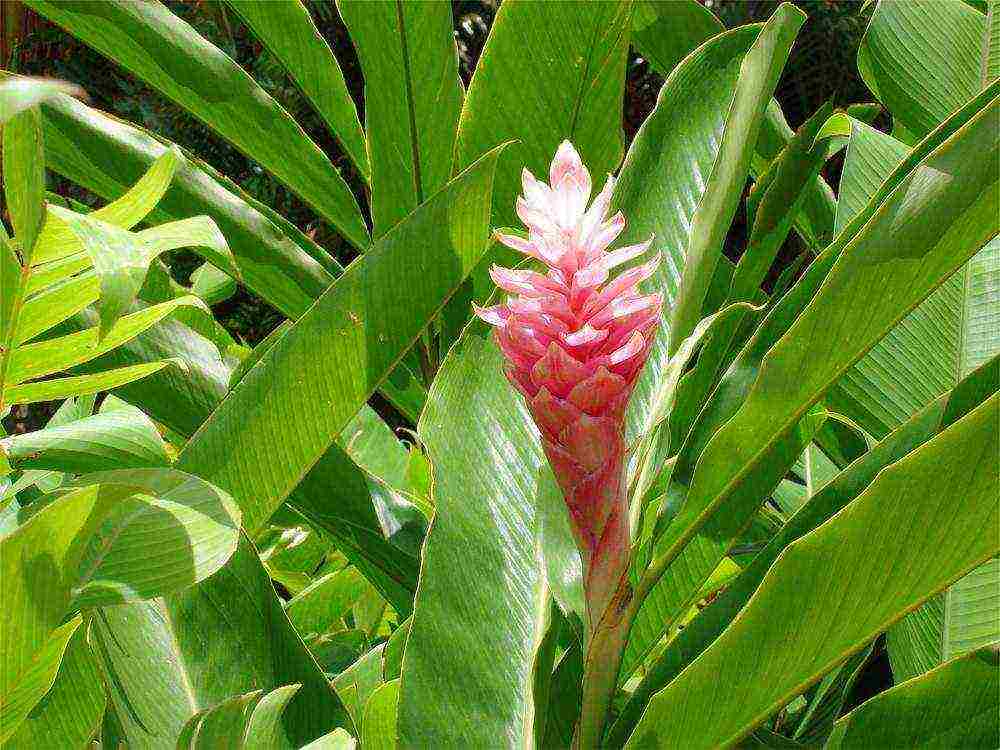
With the onset of heat, active watering and feeding are resumed. The compositions are chosen for flowering indoor plants.
Storing ginger
You can grow ginger from the root or buy it from the store, but then you have to save it. There are several ways of long-term storage:
- IN refrigerator with air access to ginger. The root is placed in a plastic food bag, put in a paper bag or wrapped in a paper napkin, and also wrapped in a paper bag. In all cases, you should try to release all the air from the bags. Place the ginger in the vegetable compartment. If a plastic bag is used, the ginger root will last for several weeks, as well as wrapped in a paper towel in a paper bag. If you pack the root without a napkin in a paper bag, it is best to use it within a week.
- IN freezer... You can freeze the whole root, shabby and cut into pieces. The whole rhizome is wrapped with cling film and placed in a bag, and then in the freezer. Grated ginger is spread in portions on a baking sheet, frozen, then put into a container and stored in the freezer for six months. The root can be cut into pieces or wedges and frozen.
- IN refrigerator without access to air... Ginger is placed in sealed jars or bags. Air is evacuated from the containers. A tag is attached to the product indicating the number of packaging. It is placed in the refrigerator.
- Alcohol or acidic liquids... Take vodka, sherry, rice wine or vinegar, lime juice, pour the ginger root with this liquid, close it tightly and put it in the refrigerator. When stored this way, ginger root can change the taste.
How to grow ginger: video


